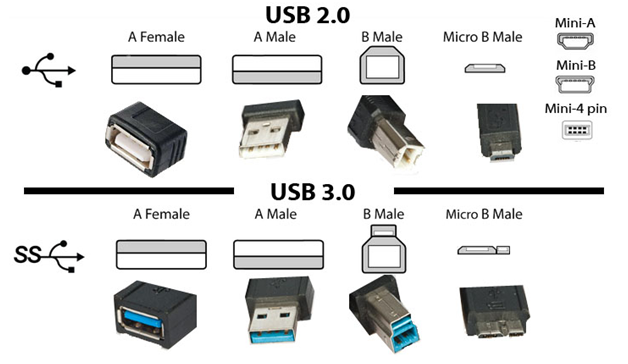Many people don’t even know you can buy different USBs, they assume there are just different memory sizes, however there is a difference between the USB 2.0 and USB 3.0.
USB 2.0 vs USB 3.0 and 3.1 is there a difference?
USB 3.0 provides better speed and more efficient power management than 2.0.
USB 2.0:
- Speed: High speed, 400 Mbps
- Signaling method: Polling mechanism
- Price: Significantly cheaper than the 3.0 and 3.1’s
- Power Usage: up to 500 mA
USB 3.0:
- Speed: 10 times faster than USB 2.0; 4.8 Gbps
- Signaling method: Asynchronous mechanism- it can send and receive data simultaneously
- Price: Depends on the amount of storage provided but can be rather pricey
- Power Usage: Up to 900mA. Allows better power efficiency with less power for idle states. Can power more devices from one hub.
USB 2.0 was released in 2000, 3.0 in 2008 and 3.1 in 2014. USB 2.0 and 3.0 have been the standard USBs until recent. USB 3.1 is the newest standard but are not as commonplace as the 2.0 and 3.0. It has higher data transfer speeds of up to 10 Gbps and the capacity to power any type of device. It has a C-type connector that plugs in without regard to orientation. This connector is small enough for modern, slim devices, tablets, and smartphones.
One noticeable difference is the color in connectors. Typically a USB 3.0 will be blue on the inside whereas 2.0 is typically black. The USB 3.0 is backwards compatible with the USB 2.0, however, the USB 3.0 product will perform a t the same level as a USB 2.0 product, so speed and power benefits will not be fully realized. USB 3.0 receptacles are electrically compatible with USB Standard 2.0 device plugs if they physically match. USB 3.0 type-A plugs and receptacles are completely backward-compatible, and USB 3.0 type-B receptacles will accept USB 2.0 and earlier plugs. However, USB 3.0 type-B plugs will not fit into USB 2.0 and earlier receptacles. This means that USB 3.0 cables cannot be used with USB 2.0 and USB 1.1 peripherals, although USB 2.0 cables can be used with USB 3.0 devices, if at USB 2.0 speeds.
When deciding which type of USB to purchase, many consumers like the pricing of the 2.0, but the 3.0 is a much better value. The 3.1 is great, but if you do not have a newer computer that is compatible, you will only get the 3.0 speeds and would not be able to use the full potential of the 3.1.
Here are some different images to show connection differences between the USB 2.0 and 3.0:

Many computers have both USB 2.0 and USB 3.0 ports. In this photo, the port on the left is USB 2.0 and the port on the right is USB 3.0.
